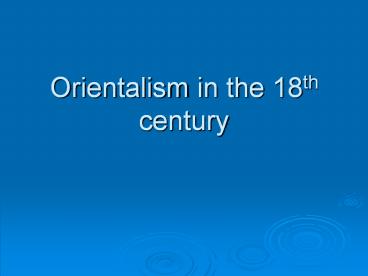Orientalism in the 18th century PowerPoint PPT Presentation
Title: Orientalism in the 18th century
1
Orientalism in the 18th century
2
What is Orientalism?
- Originally the study by Western scholars of the
Near and Far East (its culture, society,
languages). - Employed in opposition to Occidental culture
- In late 20th century, a term introduced by Edward
Said to describe the historical and ideological
process whereby false images of and myths about
the Eastern or oriental world have been
constructed by the West. Important for the
development of Post Colonial Studies.
3
Edward Said
- Said focuses his attention on the interplay
between the "Occident" and the "Orient." - The Occident is his term for the West (England,
France, and the United States), and the Orient
is the term for the romantic and misunderstood
Middle East and Far East.
4
- According to Said, the West has created a
dichotomy, between the reality of the East and
the romantic notion of the "Orient - The Middle East and Asia are depicted with
prejudice and racism. - Seen as backward and ignorant of their own
history and culture. - To fill this void, the West has created a culture
and history for them. The study of the Orient,
and also the political and cultural imperialism
of Europe in the East rests on this framework.
5
Edward Said andOrientalism
- According to Edward Said ...that by Orientalism
I mean several things, all of them, in my
opinion, interdependent. The most readily
accepted designation for Orientalism is an
academic one, and indeed the label still serves
in a number of academic institutions. Anyone who
teaches, writes about, or researches the
Orient--and this applies whether the person is an
anthropologist, sociologist, historian, or
philologist--either in its specific or its
general aspects, is an Orientalist, and what he
or she says or does is Orientalism.
6
Said continues
- Related to this academic tradition, whose
fortunes, transmigrations, specializations, and
transmissions are in part the subject of this
study, is a more general meaning for Orientalism.
Orientalism is a style of thought based upon
ontological and epistemological distinctions made
between the Orient and (most of the time) the
Occident.
7
Said continues
- Thus a very large mass of writers, among who are
poets, novelists, philosophers, political
theorists, economists, and imperial
administrators, have accepted the basic
distinction between East and West as the starting
point for elaborate accounts concerning the
Orient, its people, customs, "mind," destiny, and
so on. . . . the phenomenon of Orientalism as I
study it here deals principally, not with a
correspondence between Orientalism and Orient,
but with the internal consistency of Orientalism
and its ideas about the Orient . . despite or
beyond any correspondence, or lack thereof, with
a "real" Orientalism. (Orientalism, New York
Vintage, 1979, 1-3,5. )
8
Map of Ottoman Empire from 1300-1700
http//courses.wcupa.edu/wanko/LIT400/Turkey/maps.
htm
9
Writers
- Others who perpetuated and modified the images of
Turkey, the Ottoman and Persian Empires, and
other Islamic milieux in eighteenth Britain were - John Dryden (late 17th century Conquest of
Granada, Bajazet, and other works) - Antoine Galland, French translation of the
folktale cycle known in English as One Thousand
and One Nights, or The Arabian Nights (1704-17) - François Pétis de la Croix, Mille et un jours,
contes persanes (1710-12) - Daniel Defoe, in Roxana Or, the Fortunate
Mistress (1724), has his protagonist wear Turkish
clothing as a disguise - Montesquieu, via translations of his influential
Persian Letters (1721) - Johnson and Rasselas (1759)
- Beckford and Vathek (1786)
- Sir William Eton, A Survey of the Turkish Empire
(1799) - French travel literature about the Levant (in
French, which most upper-class Britons would
understand)
10
Images that populated the writings of many
eighteenth-century British writers Decadent
sultans wealthy beyond imagination. Lustful,
tyrannical, predatory men. Passive, secretive,
voluptuous women. Ferocious and arbitrary
justice. The mystery and irrationality of Islam.
- Many writers added to these common images by
their travel narratives and letters, or their
flights of fancy - Lady Mary Wortley Montagu writes about her
travels to Turkey in 1717 in letters that are
published posthumously in 1763 as the Turkish
Embassy Letters. - Penelope Aubin publishes her romance The Strange
Adventures of the Count de Vinevil and His Family
in 1721. - Lady Craven writes a collection of letters about
her travels in A Journey through the Crimea to
Constantinople in 1789. - Olaudah Equiano publishes his Interesting
Narrative, in 1789 part of which deals with his
reception in and observations on Turkey.
11
- Although Orientalism did not become a
well-defined style until the 19th century, its
roots can be traced to a general love of exotica
in the 18th century. - Jean Etienne Liotard
- Swiss pastel painter and engraver
- painted women dressed in Turkish costume
- chose to retain the Turkish dress and beard that
he had adopted while abroad.
Jean Etienne LiotardWoman with a Tamburine1735
12
- Luigi Mayer (c. 1755-1803)
- travelled through the Ottoman Empire between 1776
and 1794, - sketched and painted panoramic landscapes,
ancient monuments, and the Nile and its
surroundings.
Women of Caramania 1803
13
Luigi Mayer
14
Giovanni Batista Tiepolo 1696-1770)
- Painted a series of frescos at the residence of
the Prince Archbishop of Wurzburg that included
personifications of the four continents on the
ceiling of the staircase in the Kaisersaal. - Pays tribute to the Prince-Bishop. He is honoured
by the gods of Olympus, and Fame, personified by
a woman holding his portrait aloft, while
allegories of the four continents cluster around
Apollo and the Continents 1752-53Fresco,
Stairwell of the Residenz, Würzburg
15
Apollo and the Continents (America) 1752-53
FrescoStairwell of the Residenz, Würzburg
16
Joseph-Marie Vien (1716-1809)
A Young Woman in Turkish Costume Seated Playing
with a Cage-Bird 1766
17
Joseph-Marie Vien (1716-1809) Sultane Reine
Joseph-Marie VienDer Sultan
18
Standard Bearer (M. Barbault)1748
Sultane Noir (M. Castagnier)1748

